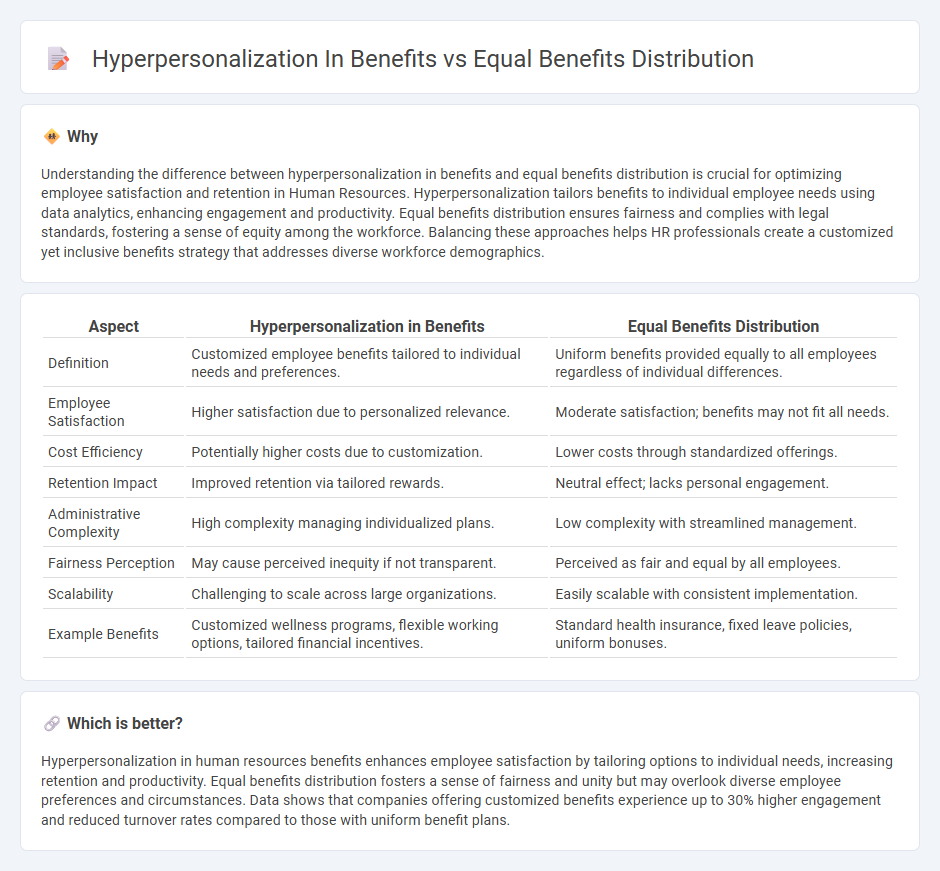
Hyperpersonalization in human resources benefits tailors offerings to individual employee needs, increasing engagement and satisfaction through customized health plans, flexible working conditions, and targeted development programs. Contrastingly, equal benefits distribution ensures uniformity and fairness but may overlook specific employee preferences and unique circumstances, potentially affecting overall morale. Explore how HR strategies balance personalization with equity to optimize workforce well-being and productivity.
Why it is important
Understanding the difference between hyperpersonalization in benefits and equal benefits distribution is crucial for optimizing employee satisfaction and retention in Human Resources. Hyperpersonalization tailors benefits to individual employee needs using data analytics, enhancing engagement and productivity. Equal benefits distribution ensures fairness and complies with legal standards, fostering a sense of equity among the workforce. Balancing these approaches helps HR professionals create a customized yet inclusive benefits strategy that addresses diverse workforce demographics.
Comparison Table
| Aspect | Hyperpersonalization in Benefits | Equal Benefits Distribution |
|---|---|---|
| Definition | Customized employee benefits tailored to individual needs and preferences. | Uniform benefits provided equally to all employees regardless of individual differences. |
| Employee Satisfaction | Higher satisfaction due to personalized relevance. | Moderate satisfaction; benefits may not fit all needs. |
| Cost Efficiency | Potentially higher costs due to customization. | Lower costs through standardized offerings. |
| Retention Impact | Improved retention via tailored rewards. | Neutral effect; lacks personal engagement. |
| Administrative Complexity | High complexity managing individualized plans. | Low complexity with streamlined management. |
| Fairness Perception | May cause perceived inequity if not transparent. | Perceived as fair and equal by all employees. |
| Scalability | Challenging to scale across large organizations. | Easily scalable with consistent implementation. |
| Example Benefits | Customized wellness programs, flexible working options, tailored financial incentives. | Standard health insurance, fixed leave policies, uniform bonuses. |
Which is better?
Hyperpersonalization in human resources benefits enhances employee satisfaction by tailoring options to individual needs, increasing retention and productivity. Equal benefits distribution fosters a sense of fairness and unity but may overlook diverse employee preferences and circumstances. Data shows that companies offering customized benefits experience up to 30% higher engagement and reduced turnover rates compared to those with uniform benefit plans.
Connection
Hyperpersonalization in benefits tailors employee rewards to individual needs and preferences, enhancing engagement and satisfaction. Equal benefits distribution ensures fairness and equity across all employees, fostering trust and inclusivity within the organization. Integrating both strategies promotes a balanced approach where personalized offerings coexist with equitable treatment, optimizing overall workforce well-being.
Key Terms
Equity
Equal benefits distribution ensures uniform access to health insurance, retirement plans, and paid leave, fostering a baseline of fairness across all employees. Hyperpersonalization tailors benefits packages to individual needs based on demographics, job roles, and life stages, enhancing relevance but potentially risking perceived equity. Explore how balancing these approaches can drive both inclusivity and employee satisfaction in your organization.
Personalization
Personalization in employee benefits harnesses data analytics and AI to tailor offerings based on individual preferences, demographics, and lifestyle needs, enhancing satisfaction and engagement. Unlike equal benefits distribution, which provides uniform benefits regardless of employee differences, hyperpersonalization optimizes resource allocation by addressing unique employee priorities and increasing perceived value. Explore how personalized benefits strategies can transform your workforce experience and improve retention rates.
Inclusion
Equal benefits distribution ensures fairness by providing identical benefits to all employees, fostering a baseline of inclusion where everyone has access to the same resources and opportunities. Hyperpersonalization in benefits tailors offerings to individual needs, promoting inclusion by recognizing diverse employee preferences and circumstances, thereby enhancing satisfaction and engagement. Explore how balancing equality and personalization can create a more inclusive workplace culture.
Source and External Links
Equitable Distributions of Income: Benefits - Explains how equitable distribution of income benefits society through reduced social problems, higher standards of living, and economic growth.
Fair and Equitable Distribution of Resources and Opportunities - Discusses fairness principles in resource distribution, contrasting equality with equity, where benefits are distributed based on contributions.
A fair inheritance: Equal vs. Equitable Distribution in Estate Planning - Compares equal and equitable distribution in estate planning, highlighting the fairness aspect of equitable distribution.
 dowidth.com
dowidth.com